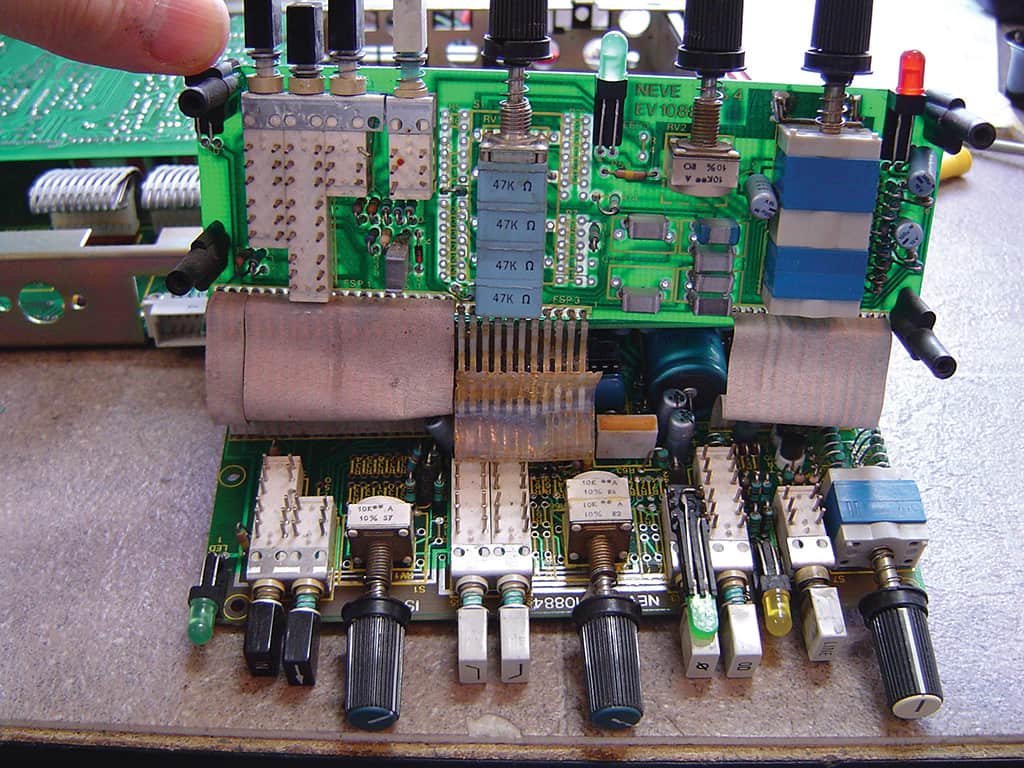
On The Bench: Repairing a Neve 51 Series Console
Not for the feint hearted.
Text: Rob Squire
Way back in Issue 65, AT editor Andy Stewart wrote of his joy in discovering the ‘Neve’ tile wedge. These little red wedges became the go-to device for locking down all the failed switches in his Mill Studio’s Neve 51 Series console. In a typical mix he’d often use a good portion of the bag of 100, for which he’d shelled out the kingly sum of three bucks. Of course, failed switch latches weren’t the console’s only problem and over the next year there’d be many a phone call between Andy and I about which area of the console to kick, poke, swap around or re-wire to keep a semblance of a mixing console operational. Often these phone calls would conclude with my suggestion to just grab a couple of solid cardboard boxes, pull a bunch of channel strips out and shoot ’em over to the workshop for some love and attention. Finally Andy relented, and as I emerged from a much needed Christmas/New Year break the first couple of boxes arrived on the doorstep; and as is often the case in this caper they arrived with the requirement that they be back within the week for a big mix project.
Fortunately, this is one ‘vintage’ console I’ve become quite familiar with over the years. I have test jigs, parts and more than a few tricks up my sleeve for the repair of these consoles, and the process has become quite streamlined. However, as I’ve made clear to Andy (and many other Neve 51 Series console owners over the years), getting these consoles back to their best is hard, time-consuming work. They’re not a doddle by any stretch and this comes at a financial penalty. That bag of red wedges was going to be looking like an even greater bargain than it did at the time!
A HISTORY LESSON
The Neve 51 Series was developed in the early 1980s and was Neve’s first fully IC-based console; a radical departure from the early 10 Series discrete, Class-A design, which has become the holy grail of vintage audio hunters everywhere.
Nevertheless, as the glossy brochure for this console states: “The 51 Series represents the culmination of 20 years of professional audio equipment design and production by Neve.” These consoles can sound great, and depending on the version, can also have fantastic operational features. As with all large-format and expensive consoles of this era, each one was custom built to the client’s specification.
There were two fundamental formats in the 51 Series: the 5104 / 5114 – a four group and stereo bus layout; and the 5116 / 5106 – an eight group and dual stereo bus format. Each supported a couple of variations of input channel with options for two or four-band EQ, a compressor/limiter/gate module, and mono or stereo inputs. Beyond the options presented in the brochure, I’ve also seen other variations built to order featuring 32 group buses, a surround panning option for a film studio console and many variations in the monitoring control and master section. Some consoles also came loaded with one (or several) of the 83046 dual-channel compressors, which for a time were worth more than the console itself.
This console harks from an era when buying a console was a serious proposition involving serious money, where the first step was always a dialogue between the manufacturer and the client as to their exact requirements before a console was built to order. This attention to detail was taken even further in the documentation that arrived with the console. In amongst the two 6cm thick service manuals there’s a chapter covering some 30 pages of actual performance test measurements: every input and output of the console, noise, distortion, max output level, frequency response… page after page of measurements of the very console you’ve just purchased, and all capped off with a signature on the last page. These days, you’d be lucky to get 30 pages of basic schematics emailed to you as a PDF, and none of them would be a record of the technical performance of your very own console.
In Australia, the 51 Series console was a popular purchase for many broadcasters. The ABC and other TV stations owned many; some specified for music recording, some for film or broadcast tasks. Naturally these consoles have now been moved on and many have been scooped up by recording studios, often for a price that seemed a bargain for a console with the ‘N’ word on it, and also often in very poor condition.


HOW IT WORKS
As mentioned, the 51 Series console is an IC-based design, almost exclusively using the relatively new (in 1980) 5534 opamp and its dual variation, the 5532. These ICs were specifically developed for audio applications – low noise, the ability to drive 600Ω, and wide bandwidth. Despite these chips now being over 30 years old, they’re still regularly employed in new pro audio equipment. In many design applications, they’re hard to beat despite the erroneous view that rattles around many a web forum that new is always better: ‘Any IC design that old simply can’t be very good!’ they mutter, and this leads to rampant IC swapping.
On one hand the broad electronic design of this console isn’t particularly unusual and many of the design elements could have come straight out of a design ‘cookbook’. However, in two particular areas Neve implemented circuit techniques that were right out of left field and rarely if ever pursued by another designer. One of these dealt with a little known quirk of basic opamp design whereby the level of high-frequency distortion can be reduced by the simple addition of one resistor. One can only presume that many designers aren’t aware of this effect. Either that, or the bean counters figure spending one cent per amplifier to shave a fraction of a percent off the distortion figures at 10kHz isn’t worth it. Neve certainly thought it was.
The other significant area that has left me scratching my head when repairing the faulty modules is the console’s entire grounding system. All good audio designers understand that ‘ground’ is a relative thing and relying on it as a reference point for all console subsections leads to the potential for all sorts of noise problems. Neve understood grounding: there’s a whole page in the manual on it that talks about exactly how to earth the console and its relationship to all outboard you might attach. However, beyond the external grounding of the console every sub-circuit within the console, every individual mic pre, each EQ, aux send, etc. has its own local ground. Rather than attempting to make ground everywhere, it appears in a console at exactly the same voltage and with 0Ω between all the points (which is an impossible task); the myriad ground points are all connected to the main grounding point with 100Ω resistors. This approach is known as ‘soft’ grounding, and if done well, effectively decouples each circuit subsection from all the others, minimising noise issues. This is a particularly unusual technique in a console, and while it achieves its aim, it can make troubleshooting a bit trickier.
THE DOWNSIDE
The downside to the 5534 opamp employed in the console is heat. The 5534 is a hungry IC opamp consuming 4mA of power supply current, and there are lots of 5534s in a 51 Series console! A typical 36-channel console will dissipate around 500 watts of heat, so most modest-sized control rooms won’t need heating in winter! This heat factor is the most significant issue pertaining to the reliability of these consoles, and the major cause of failure in a number of specific parts.
The most obvious of these is the Philips capacitors that were originally installed throughout the console, with the dreaded blue axial capacitor employed as a coupling cap in the signal paths. Many pro audio manufacturers in the UK and Europe used these capacitors in the 1980s. Why the dread? Simply that they don’t last. All electrolytic capacitors are degraded over time with heat, and with circuit boards stuffed with 5534 mini radiators all stacked back-to-back inside the 51 Series channel modules and only a small space for heat to rise out around the knobs, it gets pretty damn warm. I have a couple of 51 Series channel strips in the workshop at the moment that an owner bought on the understanding that they’d been recapped in 1998 – i.e., had all the electrolytic capacitors replaced. Indeed they had. However, the replacement caps chosen were the same Philips (now BC components) capacitors, which probably seemed like a good idea at the time – keeping the original brand. These caps, which have had less than 10 years of use, are all knackered and need to be replaced again. I always use capacitors rated for high temperature environments, these days they cost the same as standard temperature range capacitors. Time will tell how long these will last, but I’m punting on somewhere in the order of 20 years rather than less than 10. Fortunately for Andy, his console had been recapped, and not using the Phillips capacitors. With very little use since then, the capacitors are still in good condition.
All large-format 1980s consoles should be purchased with an informed idea of what it will really cost to get a reliable, fully operational console into a studio and… it will never be cheap
RECAPPING
Recapping consoles is pretty much a de rigueur activity in the workshop, however, the 51 Series has lots of capacitors; far more than in most other equivalent consoles. The amount of disassembly required to perform the capacitor replacement opens up the second big can of worms in these consoles. All input channel sub-modules – say the EQ module or the mic/line module – consist of two circuit boards back-to-back (or is that really front-to-front?). The boards are interconnected with flat ribbon-style cables through which power, audio signals, and switching contacts shoot back and forth between the two PCBs. The flat cables (or FSPs as the service manual refers to them) consist of a number of flat thin strips of metal sandwiched between two insulating sheets, usually Teflon.
Once again, over time, the heat gets to these FSPs causing the insulating sheets to fall off, leaving a bunch of conducting metal strips flapping in the breeze. Prising a pair of boards apart to replace capacitors is often the final straw for these FSPs, and the job of replacing a capacitor or two often leads to replacing the damaged flat cable. If you’re really careful not to disturb the cable too much you can do the capacitor replacement, put the two boards back together and poke the insulating sheets back into place, keeping your fingers crossed that the bare metal strips will stay in place and not conspire to touch one another.
Over the years I’ve seen all sorts of approaches to dealing with the cables. From ripping them out and replacing each strip with a group of individual insulated wires, to tricks with masking tape, glue and wishful thinking holding it all together. The best solution is to simply replace the FSP with a new one and these are still readily available. What’s more, they’re now made using a much more robust and heatproof insulating sheet. Problem is, they’re hideously expensive and time consuming to replace. Depending on the client’s budget, sometimes I’ll resort to tricks and wishful thinking rather than replace them if I reckon we can get away with it.
The biggest issue (at least to the console’s operator) is the no longer latching pushbutton switches. The dialstat switch has already received special mention in a previous OTB article and when it comes to Neve consoles from the 1980s, it’s hard to mention the brand without cursing the dialstat switch in the same sentence. These push-button switches are in some ways very cool things – they’re small and take up minimal space on the PCB. They can be made as two, four, six or eight poles, and either mounted directly to a PCB or off a front panel with wires soldered directly to them. The internal switch contacts are silver plated, which is the premier switch material, surpassing gold for its electrical properties. However, there’s no free lunch and these switches have proven themselves to be particularly unreliable both mechanically and electrically as they age. While proving highly resistant to corrosion, silver does quite readily tarnish, forming a coat of silver sulphide out of those freely available in the air. And of course, in the olden days when everyone chuffed on cigarettes over the console, there was even more sulphur hanging around ready to tarnish all those silver pins. Tarnish (or silver sulphate) is a semiconductor and there are times when it turns these dialstat switches into fuzz boxes, with each switch contact increasingly looking like a diode rather than a piece of wire. This leads to signals that are just plain distorted, and in certain circumstances non-existent! Sometimes they’ll only pass an audio signal when the level is particularly ‘hot’, whereupon they suddenly ‘break through’ and magically start working. I know of at least one 51 Series console owner who, before starting work each day, fires up a special ProTools session consisting of 24 tracks of full-scale tone – i.e., +24dBu or so – that he blasts down each channel of the console for 10 minutes or so (with the monitors turned off of course). This does wonders for zapping the switches and ensuring that there’ll be no little intermittencies or fuzz boxes on that day’s mixing.
Cleaning switches, like replacing capacitors, is also de rigueur on the workshop bench, although the dialstat switch is very fussy about which contact cleaner is used. Many of the conventional cleaning sprays actually damage the switch and I’ve only found one brand that can be used reliably.

SEEING RED
Harking back to those red tile wedges, the most significant problem with dialstat switches is the failing of the latching pin. This is a piece of shaped plastic not much bigger than fly shit that is responsible for keeping the switch locked in the ‘down’ position. In Andy’s console this was issue number one. Not too many years ago the dialstat switch was pretty much unobtainable and I recall standing around at an AES conference with a bunch of studio techs from the UK and USA trading ideas about how to deal with non-latching dialstats. It was the bane of our console servicing existence – not only are these switches found in Neve consoles, but they’re also everywhere on SSL 4000 and 6000 Series consoles. On a 48-channel SSL 4000 there are 1728 of them!
Then suddenly a couple of years back, the dialstat switch became available again, and while it was expensive, at least you could get it. Better than that I was also able to purchase just the latching pin and so shelled out and bought 1000 of them. After some time spent experimenting with cleaning techniques, I finally put in place a procedure that enabled me to remove a switch, de-tarnish and clean all the contacts, lubricate it, replace the pesky latching pin, and end up with an ‘as new’ switch. This takes time of course, but it saves about 50% of the cost of simply replacing the switch with a new one.
CONSOLE OR MILLSTONE?
The Neve 51, despite being IC-based and having lots and lots of electrolytic capacitors in the signal path, is a great sounding console. But all this prerequisite servicing work and the attendant costs can make the faint-hearted shy away. The point of all this is to be aware that large-format 1980s consoles should be purchased with an informed idea of what it will really cost to get a reliable, fully operational console into a studio and… it will never be cheap. The purchase price is only the beginning. And let’s face it, reliability is the key here. Having a big name console might look good on your gear list, but unless it works and you feel confident using it, it will quickly become a millstone around your creative neck.
I’ve been employed to refurbish lots of consoles but only twice have I ever been employed to write a technical report for a client who was thinking of purchasing a specific console. Why is that?
It’s no fun contemplating the true cost of restoring an old console, but it’s vital if you ever expect it to work properly.

















hi I would need the schematics and connection wiring of a 51 series mic preamp and dynamics… do you have it? if yes wouldn’t you be so kind to post it to me? many thks…greetings
Hello the Rob! Great article, enjoyed reading it very much.
Thing is, I’m looking for a replacement ribbon cable for my 51 module. The standard ones manufactured these days are not as thin as the original ones. Could you please reference me to a manufacturer/product that you had good experience with as a substitute? Thanks ahead.